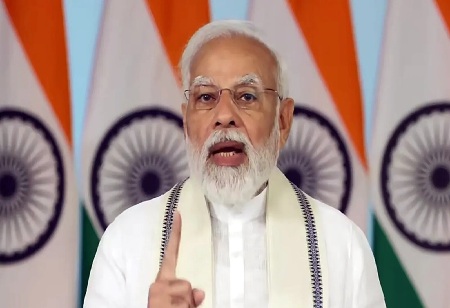India, the world's third biggest oil importing and consuming nation, achieved the target to blend 10 per cent sugarcane-extracted ethanol in petrol ahead of schedule, Prime Minister Narendra Modi said. Addressing the nation from the ramparts of the Red Fort on the 76th Independence Day, he rooted for energy independence and a nation self-sufficient in meeting its energy needs.
"We need to be Aatmanirbhar (self-sufficient) in our energy sector," he said. For a nation, 85 per cent dependent on imports for meeting its oil needs and 50 per cent for gas requirement, the key is alternate energy sources from renewable power to hydrogen and switching to electric vehicles from current petrol and diesel-run automobiles.
"From solar energy to Mission Hydrogen to adoption to EVs, we need to take these initiatives to the next level for energy independence," he said. In a bid to cut reliance NSE 0.30 % on imported oil, the government is pushing for mixing of ethanol, made from sugarcane and other agri commodities, in petrol. Modi said India achieved the target of blending 10 per cent ethanol in petrol ahead of schedule.
The target of supplying petrol mixed with 10 per cent ethanol (10 per cent ethanol, 90 per cent petrol) was achieved in June, ahead of the original schedule of November 2022. Encouraged by the success, the government advanced the target of making petrol with 20 per cent ethanol by five years to 2025. Last week, the Prime Minister had stated that 10 per cent ethanol blending had resulted in saving of about Rs 50,000 crore of foreign exchange, reduced greenhouse gas emissions and gave farmers an alternate source of income. India is the world's fifth largest producer of ethanol after the US, Brazil, EU and China. Ethanol worldwide is largely used for consumption but nations like Brazil and India also dope it in petrol.
Supply of petrol with 20 per cent ethanol will result in a saving of an estimated USD 4 billion annually. The increased blending will expand the use of renewable energy in the world's third-biggest oil importer and consumer, and help turn the nation's surplus rice and damaged food grains into ethanol. As much as 10.17 per cent of ethanol is being doped in petrol now, up from 8.10 per cent in 2020-21 and 5 per cent in 2019-20. Ethanol blending in petrol was 1.53 per cent in 2013-14.
According to the oil ministry, 2 million tonnes of crude oil was substituted due to the blending of ethanol in petrol during the first three and half months of the current fiscal year that began in April. In 2020-21, 2.14 million tonnes of crude oil was substituted and 1.34 million tonnes in the year prior to that. The volume was 0.27 million tonnes in 2013-14.
The highest ever quantity of 306.43 crore litres of ethanol has been procured by oil marketing companies in the current ethanol supply year (December 2021 to November 2022). This is up from 302.3 crore litre last year and 173 crore litre in 2019-20. Ethanol supply for mixing with petrol was 38 crore litre in 2013-14. For a 20 per cent blend, 1,000 crore litres of ethanol will be required. As the availability of ethanol increases, the equivalent amount of crude (used for petrol production) import is reduced. The Centre had announced an additional duty of Rs 2 per litre on unblended fuels starting October 2022 to incentivise blending. That duty will no longer be effective as the target of 10 per cent blend has been achieved.
